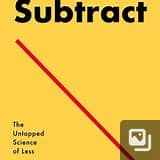The Art of Subtraction
It turns out that our response to most any problem is to add. Add an addition to your house. Add a new class to your workout. Add clothes to your wardrobe. Add information to your life. Add a personal life coach to your doctor, therapist, pastor and support group. Add a new hack to your life management repertoire. Add activities to your day.
Add, Add, Add. (Is it a coincidence that this is the acronym for Attention Deficit Disorder?)
 Apparently, our evolutionary biology, our social instincts and living in a culture of more-ality (see Lowe’s Home Improvement store slogan, “More of Everything”) all combine to make us confront most any problem or challenge by adding.
Apparently, our evolutionary biology, our social instincts and living in a culture of more-ality (see Lowe’s Home Improvement store slogan, “More of Everything”) all combine to make us confront most any problem or challenge by adding.
But in the “Math Section” at Elliott Bay books (I think it may be mis-shelved) I found an intriguing, rather light-hearted book with a different approach. Subtract: The Untapped Science of Less by a guy named Leidy Klotz, an engineer, who both advises subtraction as a way to deal with many of our problems as well as the complicated systems that almost every organization has become.
My ideas for subtraction would start with my health care provider, Kaiser Permanente. Apparently, one-third of all health care costs are administrative. I believe it. Hardly a day passes without a thick packet arriving from my Kaiser. Each and everyone contains a full page listing all the languages in which I can access services. Probably that’s required.
The mailings are supplemented by frequent emailed surveys of consumer (consumer, not patient) satisfaction. For a long time I dutifully completed these surveys and when I got to the last part asking if there was anything else I wanted to say I added, “Please stop sending these surveys. If I have a problem, I’ll tell you.” Of course that did no good. Now, when I don’t reply I get at least three more emailed surveys reminding me that I haven’t completed the first one.
When I was pastoring congregations I noticed that adding was our main go-to as well. If we felt we weren’t reaching enough people, add a program for the targeted demographic. If we wanted to ease the burden on staff, add another staff person. If we wanted to be more relevant (whatever that meant), we needed to add a committee or task force to tackle the issue du jour. The unquestioned assumption was that adding meant improvement, growth, and that we were a better church. It may have made us busier, but I’m doubtful that it ever made us better.
I took to asking, “What are the vital few things we as a church must do and do well in order to be faithful and fruitful?” Don’t add and think that this means you’ve accomplished something. Usually all you’ve added is another layer of organizational complexity — and another meeting. Figure out what the main thing is and focus on that. It was a hard sell. Every time there was some sort of new issue or passion or crisis, people wanted to add. So I was primed for Klotz’s book.
The first half is about how we are programmed to add and almost never even consider subtraction as a way to improve things. The second half looks at “science of subtraction” and how to actually do it. Along the way Klotz considers lots of examples, ranging from eliminating the Embarcadero Freeway in San Francisco (it took an earthquake to make that one happen), to taking the training wheels off kids bikes, to subtracting material from a Nike Air shoe.
My observation is that most “adds” and those who propose them are well-intended. And they always sound good. “Yes, we should do something about that!” “We must address this!” But what we seldom ask is “What are the costs of this add? And “Do they justify another board, committee, initiative or set of rules/ guidelines/ instructions, etc.?” Or perhaps more importantly, what does this have to do with our core purpose, our main thing?
Subtraction may not be our go-to, but it may be today’s most needed counter-intuitive.
![Anthony B. Robinson [logo]](https://www.anthonybrobinson.com/wp-content/themes/anthonybrobinson/images/logo.png)
![Anthony B. Robinson [logo]](https://www.anthonybrobinson.com/wp-content/themes/anthonybrobinson/images/logo-print.png)